Saudi Arabia Payments Market Size
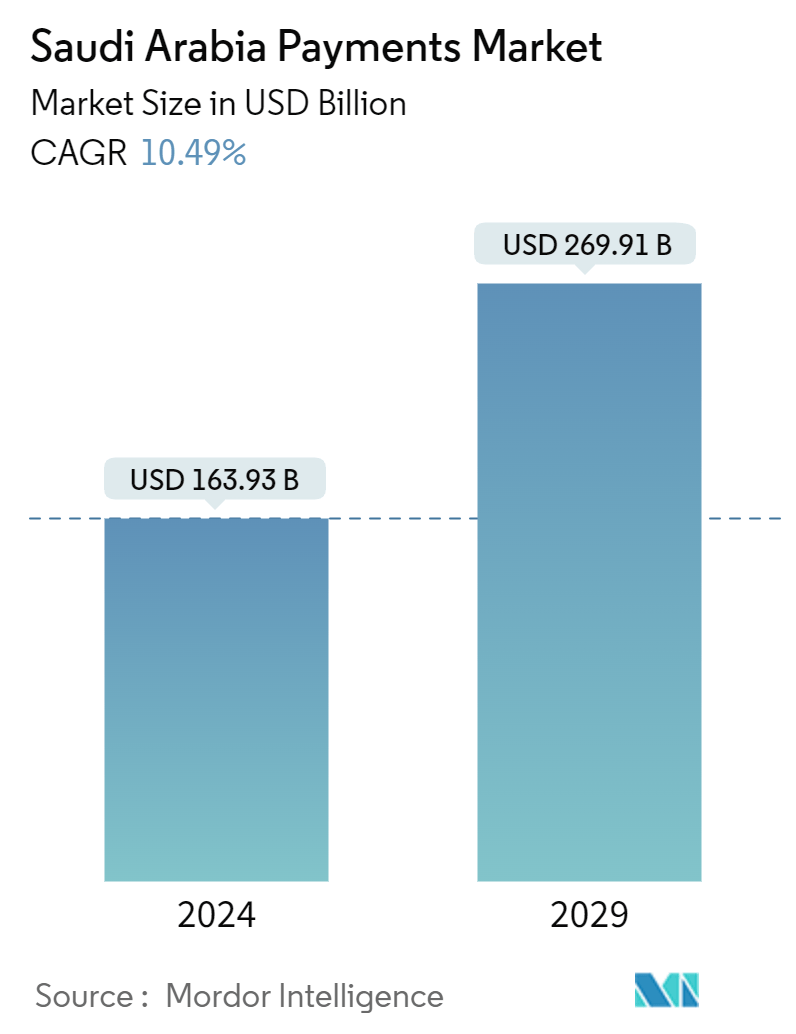
| Study Period | 2019 - 2029 |
| Base Year For Estimation | 2023 |
| Market Size (2024) | USD 163.93 Billion |
| Market Size (2029) | USD 269.91 Billion |
| CAGR (2024 - 2029) | 10.49 % |
| Market Concentration | Medium |
Major Players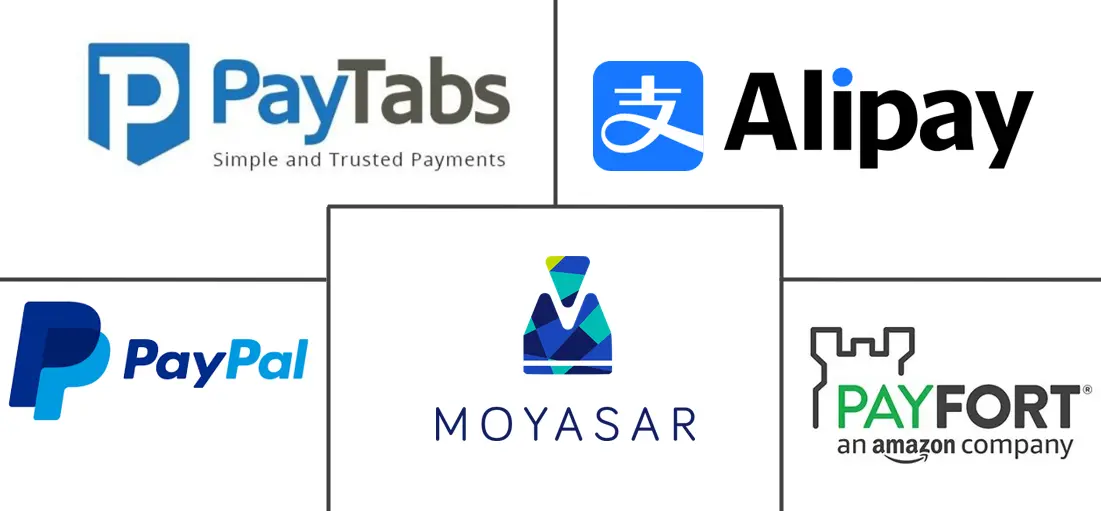
*Disclaimer: Major Players sorted in no particular order |
Saudi Arabia Payments Market Analysis
The Saudi Arabia Payments Market size is estimated at USD 163.93 billion in 2024, and is expected to reach USD 269.91 billion by 2029, growing at a CAGR of 10.49% during the forecast period (2024-2029).
The Saudi Arabian payments market is one of the most advanced markets, with payment methods that meet customers' needs and help the country’s drive toward a cashless society. According to the Cebr, the theoretical impact of real-time payments on formal GDP might increase by 2.8% by 2026. However, these are hypothetical advantages; they do not rule out the possibility of non-instant electronic or paper-based payments in the future.
- With the rapid increase in the global economy, mobile phones (especially smartphones) have become an essential part of an individual. Moreover, the internet has also become a necessary part of day-to-day life for most people worldwide. Due to this, the penetration of smartphones and internet users increased worldwide, resulting in a significant boost in the payments market.
- The increasing number of internet smartphone users is driving the Saudi Arabian payments market. Saudi Arabia is seeing an increase in smartphone usage and significant growth in smartphone penetration. With 24.2 million smartphone users, it ranks third globally, with over three-quarters of the population using smartphones.
- Increasing internet penetration and a burgeoning e-commerce sector propel Saudi Arabia's payments market. The country witnessed a significant surge in electronic payment adoption, credited to a unified strategy embraced by its financial sector. This shift is bolstered by an efficient and evolving e-payment system, which boosts transaction efficiency and bolsters financial stability.
- Market vendors are actively expanding the national payments infrastructure and refining payment services to encourage digital transactions. Furthermore, they are collaborating with partners to streamline economic activities and foster a more robust financial ecosystem. The continuous development and enhancement of these systems are crucial for maintaining the momentum in the payment market, ensuring that both consumers and businesses benefit from the advancements in digital payment technologies.
- The COVID-19 pandemic supported a significant shift in payment practice, such as a decrease in cash payments, a move from in-store to online payment methods, and the adoption of quick settlements. These shifts offered new opportunities for Saudi Arabia's payment providers.
Saudi Arabia Payments Market Trends
E-commerce is Expected to Drive the Saudi Arabian Payments Market
- With the increasing number of smartphones worldwide and high-speed cellular networks in most countries worldwide, the e-commerce industry is growing. With that, mobile transactions are also expected to grow rapidly, providing a significant boost to the mobile payments market.
- During the COVID-19 pandemic, the e-commerce industry witnessed a significant rise owing to lockdowns worldwide. Customers were reluctant to purchase from offline stores due to fear of contracting the disease. People used electronic payment methods, including mobile payment, to pay for goods and services.
- As reported by PAYPERS News, urpay, a digital wallet based in Saudi Arabia, leveraged MoneyGram's API infrastructure and network to facilitate international transactions from the Kingdom. This collaboration, indicative of MoneyGram's growing influence in the Middle East, notably amplified its digital footprint in a key global remittance market. With this partnership, MoneyGram anticipates a surge in payment volumes processed through its platform, coupled with an enriched digital service portfolio.
- Saudi Arabia's e-commerce sector is poised for robust double-digit growth, with several cross-border e-commerce opportunities. A2A payments are gaining traction in the region, emerging as the third most popular e-commerce payment method, following credit cards and digital wallets. Notably, consumers in the Middle East and Africa (MEA) are increasingly favoring digital wallets. According to FIS, digital wallets, the second most popular online payment method in MEA with a 20% share, are further expected to expand, reaching a 27% share of the e-commerce transaction value by 2026.
- As per FIS, a financial services firm, the global point-of-sale (POS) transaction value dominated by cash is projected to plummet to under 10% by 2026. The pace and reasons behind this cash decline vary across nations, with Saudi Arabia exemplifying a notable shift. In Saudi Arabia, the surge in digital wallets, notably Apple Pay and STC Pay, has been pivotal in diminishing cash usage. Despite its historical reliance on cash, Saudi Arabia is swiftly transitioning to a predominantly digital payment ecosystem, with debit and credit cards, along with digital wallets, spearheading the transformation.
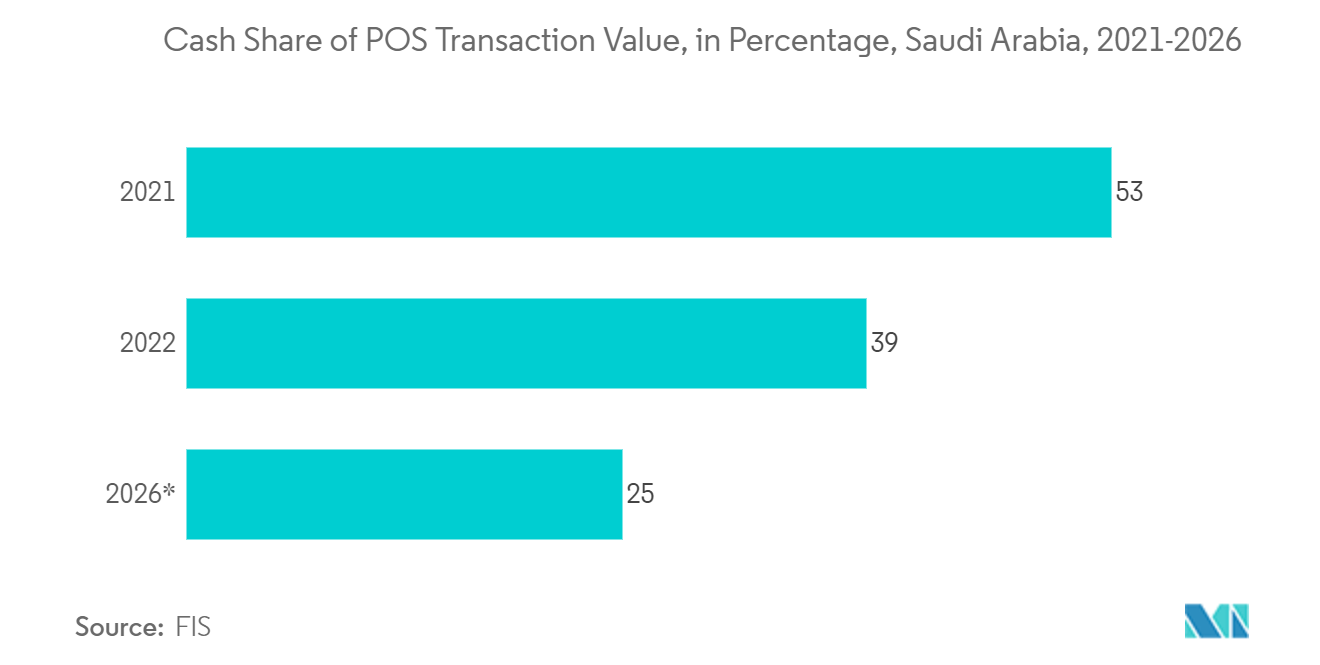
The Retail Sector is Expected to Register Significant Growth
- The retail sector is one of the top sectors in Saudi Arabia. As a result, the retail sector represents many opportunities for new business, trading, and investing. The payments market in Saudi Arabia is developing with the changing customer behavior. Trends such as mobile payments, internet banking, instant payments, and the government's growth initiatives are affecting the market.
- Citizens spend a significant share of money on categories that include food, beverages, clothing, footwear, cosmetics, body care products, furniture, appliances for the household, and leisure items, such as watches and accessories. Furthermore, various payment checkout solutions offered by top retail market players in the region are accelerating the growth of the retail sector.
- This continuous rise in the retail sector provides various opportunities for payment providers in the region to enhance their payment platforms and apps to cater to the increasing demand. Furthermore, the rising adoption of digital wallets and contactless payments by cards further provides lucrative opportunities for payment providers in the region.
- Digital wallets, spearheaded by domestic solutions like STC Pay by STC and mada Pay by Saudi Arabia’s Ministry of Finance, are swiftly capturing more shares of the e-commerce industry. SARIE, a part of Saudi Vision 2030 under the Financial Sector Development Program, aims to push non-cash transactions to 70% by 2030. Notably, non-cash transactions have surpassed cash transactions, marking a significant milestone.
- The credit landscape is diverse, with rising demand for alternative products like credit card-linked digital wallets, 'buy now pay later' (BNPL) services, and other point-of-sale (POS) financing options. In 2022, BNPL transactions accounted for 5% of the global e-commerce transaction value, a figure expected to climb to 6% by 2026. Similarly, POS financing, encompassing BNPL, retailer, and bank financing, held a 2% share of POS transaction value in 2022, a proportion projected to hold steady through 2026.
- According to the Saudi Central Bank’s (SAMA) report in April 2024, retail consumer electronic payments, a key KPI of the Financial Sector Development Program, surged to 70% of total retail payments in 2023, up from 62% in 2022. This uptick was fueled by a notable spike in payments processed through national systems, hitting 10.8 billion transactions in 2023, compared to 8.7 billion in 2022.
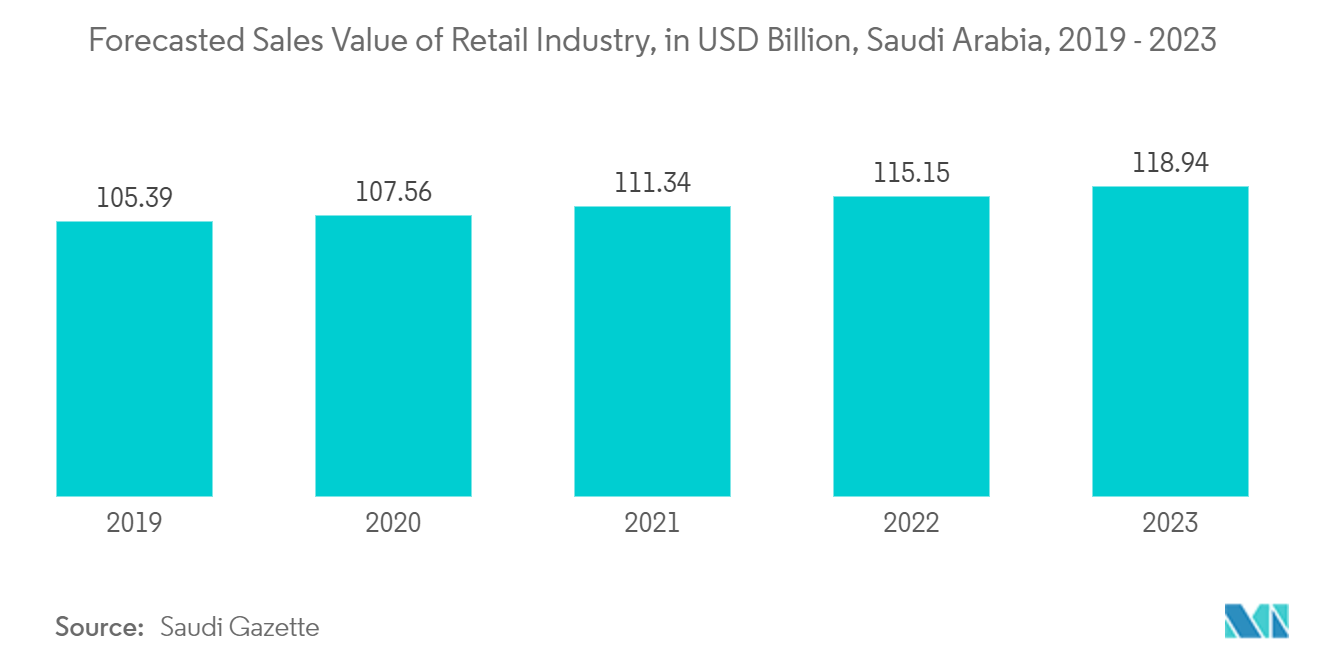
Saudi Arabia Payments Industry Overview
The Saudi Arabian payments market is semi-consolidated. Major market players include Paypal, Moyasar, Payfort, Paytabs, and Alipay. Companies operating in the market are adopting various initiatives to expand their presence, which adds to market expansion. Furthermore, the government's promising efforts to promote digital payments will strengthen market competition in the coming years.
- March 2024: Loop, a digital payments technology company licensed by the Saudi Central Bank, teamed up with Mastercard to introduce credit card and payment solutions in Saudi Arabia. By leveraging Mastercard's technology and know-how, Loop is set to revamp its offerings, paving the way for innovative financial solutions and heightened financial inclusion in the country. The collaboration is geared toward rolling out these fresh offerings to a broad spectrum, encompassing consumers, small- to medium-sized businesses (SMBs), and FinTechs.
- May 2024 - TraiCon Events announced the Fintech Revolution Summit, which was scheduled for June 2024 in Riyadh. The summit, featuring experts from banking, financial services, and insurance, alongside fintech leaders, delved into emerging trends and investment prospects in the finance sector. Notably, sponsors and exhibitors, including fintech and banking technology providers, cybersecurity firms, e-payment companies, and payment gateway providers, converged to discuss the future of Saudi Arabia's financial landscape. The dialogue centered on the nation's pivot toward digital banking, innovative payment models, and technology-centric business continuity strategies.
Saudi Arabia Payments Market Leaders
-
PayPal
-
Moyasar
-
Payfort
-
Paytabs
-
Alipay
*Disclaimer: Major Players sorted in no particular order
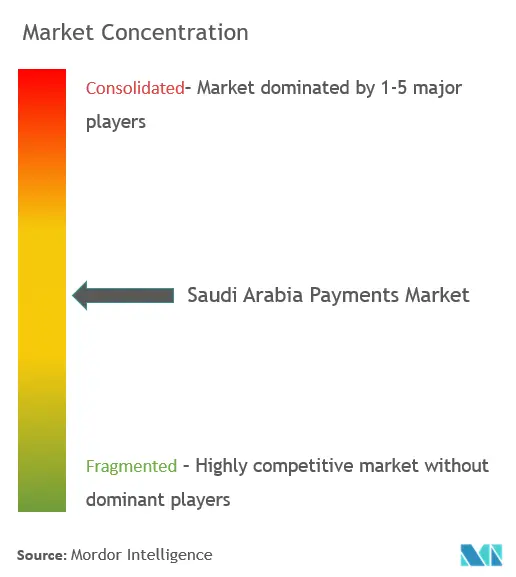
Saudi Arabia Payments Market News
- June 2024: Saudi Arabia became a participant in a multi-country initiative focused on central bank digital currencies (CBDCs). Specifically, the country joined Project mBridge, an endeavor aimed at developing a platform for multi-central bank digital currencies, with a primary focus on facilitating seamless cross-border payments. Project mBridge seeks to revolutionize international payments by making them faster, more cost-effective, and better tailored for regions that lack robust ties to the global financial network. By establishing multi-CBDC frameworks that unify various jurisdictions under a single technical infrastructure, there is a strong potential to not only enhance the current payment systems but also to make cross-border transactions immediate, cost-efficient, and universally accessible, with swift final settlements.
- April 2024: The Saudi National Bank (SNB) collaborated with Mastercard to introduce the Flexi credit card, a pioneering offering in Saudi Arabia. This card empowers customers to make purchases and settle payments in four convenient installments, all without incurring any fees. Notably, this initiative heralded the introduction of the Mastercard Installments Program in the Kingdom. SNB's initiative underscores its dedication to pioneering and holistic payment solutions. The Flexi credit card, a virtual offering, is designed to cater to a diverse customer base, ensuring accessibility across various demographics.
Saudi Arabia Payments Market Report - Table of Contents
1. INTRODUCTION
- 1.1 Study Assumptions and Market Definitions
- 1.2 Scope of the Study
2. RESEARCH METHODOLOGY
3. EXECUTIVE SUMMARY
4. MARKET INSIGHTS
- 4.1 Market Overview
- 4.2 Industry Stakeholder Analysis
-
4.3 Industry Attractiveness-Porter's Five Forces Analysis
- 4.3.1 Bargaining Power of Suppliers
- 4.3.2 Bargaining Power of Buyers/Consumers
- 4.3.3 Threat of New Entrants
- 4.3.4 Threat of Substitute Products
- 4.3.5 Intensity of Competitive Rivalry
- 4.4 Evolution of the payments landscape in the country
- 4.5 Key market trends pertaining to the growth of cashless transaction in the country
- 4.6 Impact of COVID-19 on the payments market in the country
5. MARKET DYNAMICS
-
5.1 Market Drivers
- 5.1.1 Growth in the e-Commerce Industry drives the Payments Market in Saudi Arabia
- 5.1.2 Key Retailers and the Government are Promoting Market Digitization Through Activation Programs
- 5.1.3 Growth of Real-time Payments, Buy Now Pay Later services in the country
-
5.2 Market Challenges
- 5.2.1 Lack of a standard legislative policy remains especially in the case of cross-border transactions
-
5.3 Market Opportunities
- 5.3.1 Move towards Cashless Society
- 5.3.2 New Entrants to Drive Innovation Leading to Higher Adoption
- 5.4 Key Regulations and Standards in the Digital Payments Industry
- 5.5 Analysis of major case studies and use-cases
- 5.6 Analysis of key demographic trends and patterns related to payments industry in the country (Coverage to include Population, Internet Penetration, Banking Penetration/Unbanking Population, Age & Income etc.)
- 5.7 Analysis of the increasing emphasis on customer satisfaction and convergence of global trends in the country
- 5.8 Analysis of cash displacement and rise of contactless payment modes in the country
6. Market Segmentation
-
6.1 By Mode of Payment
- 6.1.1 Point of Sale
- 6.1.1.1 Card Payments (includes Debit Cards, Credit Cards, Bank Financing Prepaid Cards)
- 6.1.1.2 Digital Wallet (includes Mobile Wallets)
- 6.1.1.3 Cash
- 6.1.1.4 Others
- 6.1.2 Online Sale
- 6.1.2.1 Card Payments (includes Debit Cards, Credit Cards, Bank Financing Prepaid Cards)
- 6.1.2.2 Digital Wallet (includes Mobile Wallets)
- 6.1.2.3 Others (includes Cash on Delivery, Bank Transfer, and Buy Now, Pay Later)
-
6.2 By End-user Industry
- 6.2.1 Retail
- 6.2.2 Entertainment
- 6.2.3 Healthcare
- 6.2.4 Hospitality
- 6.2.5 Other End-user Industries
7. Competitive Landscape
-
7.1 Company Profiles
- 7.1.1 PayPal
- 7.1.2 Alipay
- 7.1.3 Moyasar
- 7.1.4 Payfort
- 7.1.5 Paytabs
- 7.1.6 Hyperpay
- 7.1.7 STC Pay
- 7.1.8 Bayan Portfolio
- 7.1.9 Mada Pay
- 7.1.10 Apple Pay
- *List Not Exhaustive
8. Investment Analysis
9. Future Outlook of the Market
** Subject To AvailablitySaudi Arabia Payments Industry Segmentation
The payments market is segmented by two modes of payment - POS and e-commerce. E-commerce payments include online purchases of goods and services, such as purchases on e-commerce websites and online booking of travel and accommodation. However, it does not include online purchases of motor vehicles, real estate, utility bill payments (such as water, heating, and electricity), mortgage payments, loans, credit card bills, or purchases of shares and bonds. As for POS, all transactions that occur at the physical point of sale are included in the market scope. It includes traditional in-store transactions and all face-to-face transactions, regardless of where they take place. Cash is also considered for both cases (cash-on-delivery for e-commerce sales).
The Saudi Arabian payments market is segmented by mode of payment (point of sale (card payments, digital wallet, cash, and others), online sale (card payments, digital wallet, and others)), and end-user industry (retail, entertainment, healthcare, hospitality, and other end-user industries). The market sizes and forecasts are provided in terms of value (USD) for all the above segments.
| By Mode of Payment | Point of Sale | Card Payments (includes Debit Cards, Credit Cards, Bank Financing Prepaid Cards) |
| Digital Wallet (includes Mobile Wallets) | ||
| Cash | ||
| Others | ||
| By Mode of Payment | Online Sale | Card Payments (includes Debit Cards, Credit Cards, Bank Financing Prepaid Cards) |
| Digital Wallet (includes Mobile Wallets) | ||
| Others (includes Cash on Delivery, Bank Transfer, and Buy Now, Pay Later) | ||
| By End-user Industry | Retail | |
| Entertainment | ||
| Healthcare | ||
| Hospitality | ||
| Other End-user Industries |
Saudi Arabia Payments Market Research FAQs
How big is the Saudi Arabia Payments Market?
The Saudi Arabia Payments Market size is expected to reach USD 163.93 billion in 2024 and grow at a CAGR of 10.49% to reach USD 269.91 billion by 2029.
What is the current Saudi Arabia Payments Market size?
In 2024, the Saudi Arabia Payments Market size is expected to reach USD 163.93 billion.
Who are the key players in Saudi Arabia Payments Market?
PayPal, Moyasar, Payfort, Paytabs and Alipay are the major companies operating in the Saudi Arabia Payments Market.
What years does this Saudi Arabia Payments Market cover, and what was the market size in 2023?
In 2023, the Saudi Arabia Payments Market size was estimated at USD 146.73 billion. The report covers the Saudi Arabia Payments Market historical market size for years: 2019, 2020, 2021, 2022 and 2023. The report also forecasts the Saudi Arabia Payments Market size for years: 2024, 2025, 2026, 2027, 2028 and 2029.
What are the growth opportunities in the Saudi Arabia Payments Market?
The growth opportunities in the Saudi Arabia Payments Market are a) Continued government support for digital payments through policies and infrastructure development can accelerate adoption b) Development of new payment methods like contactless payments, QR codes, and instant transfers can attract new users
What are the growth opportunities in the Saudi Arabia Payments Market?
The growth opportunities in the Saudi Arabia Payments Market are a) Continued government support for digital payments through policies and infrastructure development can accelerate adoption b) Development of new payment methods like contactless payments, QR codes, and instant transfers can attract new users
Saudi Arabia Payments Industry Report
The payments market in Saudi Arabia is experiencing robust growth, transitioning from traditional cash-based transactions to digital payments. This shift is driven by rapid technological advancements, increased smartphone and internet penetration, and strong government support through regulatory reforms promoting cashless transactions. The market, segmented by payment modes such as point of sale and online transactions, includes card payments and digital wallets, catering to industries like retail, entertainment, healthcare, and hospitality. Consumer preferences for convenient, fast, and secure transaction methods are reshaping market dynamics. As digital payments in Saudi Arabia continue to evolve, the landscape offers enhanced payment solutions that meet the needs of the modern financial ecosystem. For detailed insights, Mordor Intelligence™ provides statistics on market share, size, and revenue growth rate, including a market forecast outlook and historical overview. Download a free PDF sample report from Mordor Intelligence™ Industry Reports.



